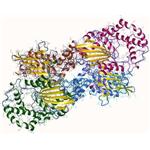Acid phosphatases and Phosphatase, Acid from wheat germ
May 27,2024
Introduction
Acid phosphatases (Phosphatase, Acid), also known as orthophosphoric monoester phosphohydrolase (EC 3.1.3.2), are a class of enzymes that catalyze transphosphorylation events as well as the hydrolysis of certain orthophosphate esters in acidic media. These enzymes are acid phosphatases, phosphoprotein phosphatases, or ATPases because they hydrolyze many phosphomonoesters with various structural variations and have a broad, overlapping substrate specificity.
They are one of the most pervasive enzymes and are abundantly present in nature. They are present in various animal organs, including the kidney, liver, spleen, erythrocytes, blood plasma, seeds of higher plants, fungi, yeasts, fungi, fruits, and erythrocytes. This widespread distribution in lower and higher creatures raises the possibility that they play a role in fundamental biological reactions[1].
Plant acid phosphatases
Plant acid phosphatases have been characterized in sweet potato tubers, pea seeds, etc. Studies of acid phosphatases from various plant sources suggest their roles during the solubilization of macromolecular organic phosphates in soils and the mobilization of phosphorus reserves during germination.
In wheat, several kinds of phosphatase isozymes exist in the leaves, roots, plant tops, and germs. The extract from wheat plant tops appears to contain a distinct acid phosphatase isozyme under the conditions of phosphorus deficiency. In wheat seeds, changes in isozyme patterns during the various stages of germination have been studied, and recently, using isoelectric focusing gel and activity staining, the gibberellic acid-induced increase in activity of a particular isozyme was also studied[2].
Wheat germ acid phosphatase

Commercial wheat germ acid phosphatase (WGAP; Phosphatase, Acid from wheat germ) is extracted from the germ/embryo of wheat plants and is commonly used in vitro in many biochemistry laboratories. Specifically, its availability and inexpensive cost have historically made it a common choice for many projects that require a broad specificity phosphatase, including those in education and research. While wheat germ acid phosphatase implies a singular protein, it typically refers to a commercial preparation of partially purified protein, which is known to contain multiple proteins.
Three hundred and thirty-seven Triticum aestivum proteins were identified in the dephosphorylating fractions of the commercial preparation of wheat germ acid phosphatase. These proteins fall into one of seven broad biological function categories: metabolism, defense/detox, embryo/seed-specific, regulation, macromolecule production, signaling/movement, or unknown. Each of these genes was also categorized by their chemical function: hydrolase, oxidoreductase, lyase, transferase, isomerase, ligase, translocase, non-enzyme, and unknown chemical function. As assessed by total spectrum counts, the most prevalent fifteen proteins in the mixture included five heat shock proteins, three beta-amylases, three glucose/ribitol dehydrogenases, three enolases, and one aminopeptidase. Therefore, despite its name and known activity, the composition of commercial wheat germ acid phosphatase is not primarily phosphatase, even after an additional purification step[3].
References
[1] Lokesh Sharma. “The multifaceted nature of plant acid phosphatases: purification, biochemical features, and applications.” Journal of Enzyme Inhibition and Medicinal Chemistry 38 1 (2023): 2282379.
[2] Yasuaki Kawarasaki, Tsuneo Yamane, Hideo Nakano. “Purification and some properties of wheat germ acid phosphatases.” Plant Science 119 1 (1996): Pages 67-77.
[3] Veronica R Moorman, Alexandra M Brayton. “Identification of individual components of a commercial wheat germ acid phosphatase preparation.” PLoS ONE 16 3 (2021): e0248717.
- Related articles
- Related Qustion
Supplementation with pyridoxal 5'-phosphate monohydrate can synthesize neurotransmitters such as dopamine and serotonin, maintaining a healthy nervous system.....
Nov 4,2025Biochemical EngineeringGlycine is the smallest protein amino acid, a non-essential amino acid that occurs naturally in humans, animals and many mammals.....
May 27,2024Amino Acids and ProteinsPhosphatase, Acid
9001-77-8You may like
- Diosgenin:Uses,Functions and Synthesis
Dec 12, 2025
- Biosynthesis of Cyclopamine from Cholesterol
Dec 10, 2025
- Synthesis of ribociclib
Dec 10, 2025
Phosphatase, Acid manufacturers
- Acid phosphatase
-

- $0.00 / 1removed
- 2025-12-12
- CAS:9001-77-8
- Min. Order:
- Purity:
- Supply Ability: 10g
- Phosphatase
-

- $0.00 / 1g
- 2025-07-08
- CAS:9001-77-8
- Min. Order: 1g
- Purity: 98%
- Supply Ability: 100kg
- Phosphatase, Acid froM Wheat GerM
-

- $0.00 / 1KG
- 2025-06-27
- CAS:9001-77-8
- Min. Order: 1KG
- Purity: 99%
- Supply Ability: 500000kg






